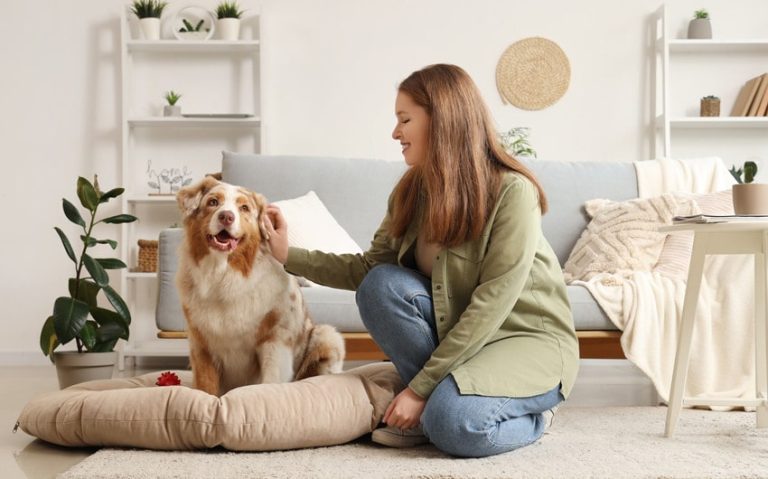Catnip, widely adored by cats for its euphoric effects, often leaves dog owners wondering, “Is catnip bad for dogs?” This article investigates the impact of catnip on canine friends, aiming to provide clarity and guidance for pet owners.
What is Catnip?

Catnip, scientifically known as Nepeta cataria, is a perennial herb from the mint family and is native to Europe and Asia. Its allure for cats lies in nepetalactone, an essential oil found in the leaves, stems, and seeds of the plant.
This compound triggers a stereotypical behavior in two-thirds of cats, which includes sniffing, licking, chewing, head shaking, rolling, and rubbing. These reactions last for about 10 to 15 minutes, after which cats temporarily lose interest due to a temporary immunity to nepetalactone’s effects.
Historically, catnip has been used for various purposes beyond entertaining cats. It has medicinal properties for humans, including as a mild sedative, and has been used in traditional remedies to treat conditions like insomnia, anxiety, and minor aches.
The plant’s easy cultivation and robustness make it a favorite in gardens, attracting beneficial insects and serving as a natural pest deterrent. Its versatility and appeal across species underscore its unique place in both the natural world and human culture.
Catnip and Dogs: The Basic Differences

When it comes to dogs, the reaction to catnip is markedly different from the enthusiastic response seen in cats. This disparity is largely due to the way nepetalactone interacts with the olfactory receptors in cats, a mechanism that is not replicated in dogs.
Dogs may show mild curiosity towards catnip, possibly influenced by its aroma or the behavior of cats in multi-pet households, but they lack the specific receptor sensitivity that makes catnip so captivating to their feline counterparts.
Dogs’ indifference to catnip is indicative of the species-specific nature of many herbal compounds. While nepetalactone has a profound effect on most cats, triggering a euphoric state that mimics feline pheromones associated with mating, dogs are more likely to be indifferent. They might sniff or play with catnip toys due to their inherent playfulness or curiosity, but without the same neurological stimulation cats experience.
Furthermore, while cats may ingest small amounts of catnip with no adverse effects, dogs have a different digestive system and dietary requirements. This means that even if a dog shows interest in catnip, it’s not necessarily a substance that benefits them nutritionally or behaviorally.
In essence, the difference in response to catnip between cats and dogs is a fascinating example of how a single plant can have diverse effects across animal species, highlighting the complexity of nature’s interactions.
Is Catnip Bad for Dogs?

The question of whether catnip is bad for dogs garners interest due to the stark difference in reactions between cats and dogs to this herb. While catnip is famously known for its stimulating effects on cats, the impact on dogs is considerably less dramatic, leading to a common inquiry from dog owners about its safety and potential benefits or harms.
General Safety of Catnip for Dogs
Primarily, it’s important to understand that catnip is not inherently toxic or harmful to dogs. The active ingredient, nepetalactone, which induces a euphoric response in cats, does not affect dogs in the same way. Most dogs will show little to no interest in catnip, and those that do might simply sniff, chew, or play with catnip toys out of curiosity rather than experiencing a pharmacological effect.
Potential Benefits of Catnip for Dogs
While the effects of catnip on dogs are not as profound as they are on cats, there are still several potential benefits that catnip may offer to dogs, albeit in a more subtle manner. Below are some subsections elaborating on these benefits.
1. Calming Anxiety and Stress
Catnip has been noted to have a mild sedative effect on dogs, which can be beneficial in situations where a dog is experiencing anxiety, stress, or hyperactivity. This can include scenarios such as thunderstorms, fireworks, or unfamiliar environments. The calming effect is attributed to the nepetalactone in catnip, which, while not intoxicating dogs, can still provide a soothing influence.
2. Aiding Sleep
For dogs with sleep disturbances, a small amount of catnip before bedtime may help in promoting a more restful sleep. This use should be occasional rather than routine, ensuring it remains a safe and effective tool for nights when sleep is particularly challenging.
3. Stimulating Appetite
In cases where a dog is experiencing a temporary loss of appetite due to stress or illness, catnip can serve as a mild appetite stimulant. By encouraging eating, it can help a dog regain strength and recover more quickly.
4. Soothing Upset Stomach
Catnip has mild antispasmodic properties, which can help soothe minor digestive issues such as gas or spasms. It’s important to note, however, that for serious or persistent digestive problems, veterinary consultation is necessary.
Risks and Considerations
While not toxic, there are still considerations to keep in mind when introducing catnip to dogs. The primary concern is the possibility of gastrointestinal upset, especially if a dog consumes a large amount of catnip. Symptoms may include vomiting or diarrhea, which, while typically mild and self-limiting, could cause discomfort to the dog.
Another consideration is the dog’s individual health status. Dogs with chronic health issues, especially those affecting the liver, kidneys, or digestive system, may be more sensitive to new substances, including catnip. Thus, consulting with a veterinarian before introducing catnip or any new herb is prudent.
In summary, catnip is not bad for dogs in the sense of being toxic or harmful when used appropriately. However, its effects are not as beneficial or significant as they are for cats, and any use should be monitored for signs of gastrointestinal distress or allergic reactions.
As with any supplement or dietary change, moderation is key, and the decision to include catnip in a dog’s routine should be informed by a veterinary professional’s advice tailored to the individual dog’s health and dietary needs.
How to Safely Introduce Catnip to Your Dog

Introducing catnip to your dog can be a beneficial and enjoyable experience if done correctly and safely. Below are steps and considerations to ensure the introduction process is both effective and secure for your pet.
1. Start with Small Amounts
Gradual Introduction: Begin by offering a small pinch of dried catnip or a catnip-infused toy to your dog. This allows you to observe their reaction and ensures that they do not consume too much at once, reducing the risk of gastrointestinal upset.
Monitor Responses: Keep an eye on your dog’s behavior and physical responses after their initial exposure to catnip. Signs of relaxation or mild curiosity are normal, but you should also be vigilant for any signs of discomfort or adverse reactions.
2. Choose the Right Form
Dried Catnip: This is the most common way to introduce catnip. Ensure it’s pure and not mixed with other herbs or additives that could be harmful to your dog.
Toys and Treats: Catnip-infused toys or treats designed for dogs can be a safe way to introduce this herb. These products typically contain small, controlled amounts of catnip, minimizing the risk of overexposure.
Fresh Catnip: If you have access to fresh catnip, you can offer a small leaf for your dog to sniff or chew. Ensure the plant hasn’t been treated with pesticides or other chemicals.
3. Observe and Adjust
Adverse Reactions: While rare, some dogs may have a mild allergic reaction to catnip. Signs could include sneezing, coughing, or itching. If you notice any of these symptoms, discontinue use immediately and consult your veterinarian.
Positive Interactions: If your dog shows a positive interest in catnip without any adverse effects, you can gradually offer it more frequently, though it should still be considered a treat rather than a regular part of their diet.
4. Consult Your Veterinarian
Health Considerations: Before introducing any new element to your dog’s diet or routine, it’s wise to consult with a veterinarian. This is especially important for dogs with pre-existing health conditions, dietary restrictions, or those on medication.
Professional Guidance: A vet can provide personalized advice based on your dog’s specific health profile, including recommendations on dosage and frequency for using catnip as a supplement or treat.
5. Safe Practices
Avoid Overfeeding: Even if your dog enjoys catnip and responds well, it’s important to avoid giving them too much. Treat catnip as a special treat rather than a daily supplement to prevent any potential digestive issues.
Keep Fresh Water Available: Ensure your dog has access to fresh water, especially when introducing new treats or supplements like catnip, to help them stay hydrated and flush their system.
By following these guidelines, you can safely introduce catnip to your dog’s routine, potentially providing them with calming benefits and a new form of enrichment. Always prioritize your pet’s safety and well-being by observing their reactions closely and consulting with a veterinarian when in doubt.
Frequently Asked Questions
1. Can all dogs have catnip?
While catnip is generally safe for most dogs in small quantities, individual dogs may react differently. Dogs with known allergies or sensitivities should be introduced to catnip cautiously, under the guidance of a veterinarian. Always observe your dog closely after introducing catnip for the first time.
2. How often can my dog have catnip?
Catnip should be considered an occasional treat rather than a regular part of your dog’s diet. Limit catnip exposure to once a week or less, especially if using it as a dietary supplement or a calming aid. This helps prevent potential digestive issues and maintains its effectiveness as a treat or training tool.
3. What signs should I watch for if my dog reacts badly to catnip?
Signs of a negative reaction to catnip in dogs include excessive drooling, vomiting, diarrhea, or signs of discomfort such as pacing or whimpering. If you notice any unusual behavior or physical symptoms after your dog has been exposed to catnip, discontinue its use immediately and consult your veterinarian.
4. Can I grow catnip at home for my dog?
Yes, you can grow catnip at home for both your cats and dogs. Ensure it’s grown in a pet-safe manner, avoiding the use of pesticides or harmful chemicals. Fresh catnip can be offered to your dog under supervision, allowing them to sniff or nibble on the leaves.
5. Does catnip help with dog training?
While catnip does not have the same effect on dogs as it does on cats, some dog owners use catnip-infused toys as part of training or play. The novel scent can make toys more interesting to dogs, potentially aiding in training exercises that require focus or motivation. However, its effectiveness will vary from one dog to another.
6. Can catnip be used to treat health issues in dogs?
Catnip should not be used as a primary treatment for health issues in dogs without consulting a veterinarian. While it may offer mild sedative benefits and digestive aid in some cases, it is not a substitute for professional medical advice and treatment for underlying health conditions.
Conclusion
In conclusion, catnip, in moderation, is generally safe for dogs but doesn’t excite them as it does cats. The key to using catnip safely lies in observing your dog’s reaction and consulting with a veterinarian for personalized advice. Responsible pet ownership and awareness can ensure that both your feline and canine companions enjoy their respective treats and toys safely.







